javascript operators you must learn every day_javascript skills
Hello readers, I have already roughly understood the role of Javascript and some basic function declarations and variable declarations. Today we will continue to explain the previous content. Let’s take a look at the logic of javscript (forward sequence, branch , loop) and some simple operators
Let’s talk about some simple operation operators
- + Plus sign: 1. Used to calculate the sum of two numbers, 2. Used to splice two strings
- - Minus sign: 1. Used to calculate the difference between two numbers, 2. Used in front of a number to identify a negative number
- * Multiplication sign: used to calculate the product of two numbers
- / Division sign: used to calculate the quotient obtained after dividing the dividend by the divisor
- % Remainder: Used to calculate the remainder after dividing the dividend by the divisor (the calculation here is an integer division, and the remainder after integer division will be obtained)
- = Assignment: used to assign a value (can be an object, function, number, string, Boolean) to a variable
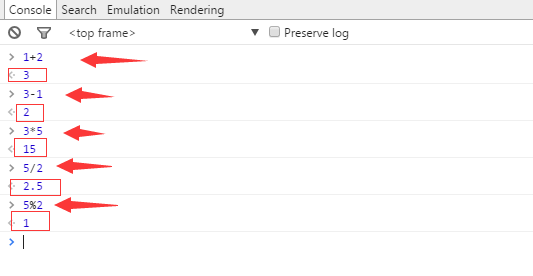
Here, we can clearly see that the operators display the results of the operations. I don’t need to go into details about addition, subtraction, multiplication and division. I believe everyone’s calculation skills should be better than mine, because I only graduated from middle school. That's it. What I want to talk about a little more is the remainder operation. In the above example, 5% 2 takes the remainder and gets 1. It is calculated like this, 5÷ 2 = 2... 1. You should have seen this in the second grade of elementary school. Calculate, dividend ÷ divisor = quotient...remainder, this remainder is the result of the remainder operation, and the equal symbol mentioned yesterday, which is the var temp = value used for assignment; we use the var keyword to To declare a variable, use = to assign a value to you. The type of the value can be an object, a function, a number, a string, or a Boolean. As I have told you before, what a function is is a function body declared with function. That is a function. , Needless to say numbers, strings are just a string of strings enclosed in quotation marks, and Boolean values are a type with only two values, true and false, and there is no third one.
Let’s take a look at what the various values look like
//这里我们给了一个空对象(null)
var temp_1 = null;
//这里我们给一个函数
var temp_2 = function(){
console.log("Write Something");
};
//这里我们给了一个字符串
var temp_3 = "My name is MrDream";
//这里我们给了一个boolean值
var temp_4 = true;
These basic operations should be clear to everyone. I hope that readers will not be anxious when they see these basic things. We are still in the introductory introduction stage, so everyone must understand these basic things. In the article, I will talk about more things. Otherwise, if the foundation is not laid well, later, when I talk about something that you think is awesome, it will be meaningless if you can only copy the code and use it, and you cannot write it independently. Something you want.
Let’s further understand what the operator looks like after a small upgrade? (Note: At present, I only talk about some basic operators, and some special operators. I will explain them in some applications later, and then the understanding will be deeper)
- += Addition: First add the two operands, and then assign the added value to the first operand
- -= Subtraction: First subtract the two operands, and then assign the added value to the first operand
- *= Multiplication and so on: first multiply the two operands, and then assign the added value to the first operand
- /= Division, etc.: First divide the two operands, and then assign the added value to the first operand
- %= Remainder: First perform the remainder operation on the two operands, and then assign the added value to the first operand
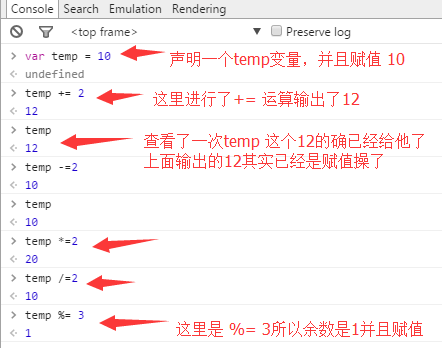
Here are some simple comparison operators
- == Equal: Determine whether the objects on both sides of the operator are equal
- === Absolute equality: Determine whether the objects on both sides of the operator are absolutely equal
- !== Absolutely not equal: Determine whether the objects on both sides of the operator are absolutely unequal
- != Not equal: Determine whether the objects on both sides of the operator are not equal
- || Or (or): First determine whether the objects on the left and right sides of the operator are "non-empty objects or non-undefined objects". If both are, return the value on the right. If If there is a value that is not, return the value that is not that value
- && And (and): First determine whether the objects on the left and right sides of the operator are "non-empty objects or non-undefined objects". If they are neither, return the value on the right. If there is a value If yes, return the value that is yes. If both are yes, return the one on the left.
- ! Negation (not): After converting a value into a Boolean value, then negate it
(Note: The or and negation operators mentioned here are explained using everyone’s common understanding of logic. In fact, the internal operations involve the results of binary OR and NOT operations. We We’ll talk more about binary below) Let’s look at some examples
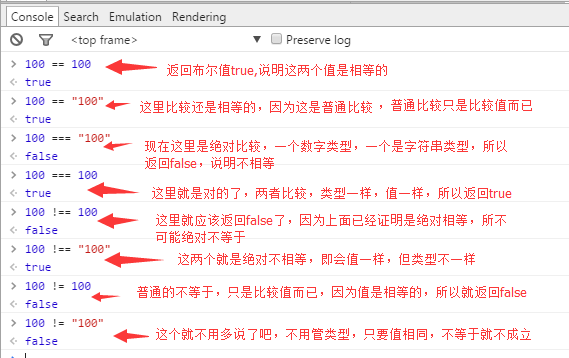
The following is a little bit about the operations of OR and NOT, which is a little more difficult to understand
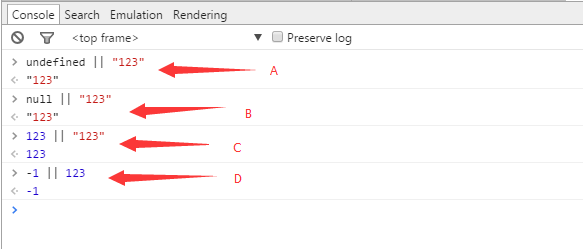
Looking at the picture, at A, because there is no object defined on the left side of the operator, the value on the right is returned; at B, because the left side is an empty object, the value on the right is returned; at C, because there is a real value number 123 on the left , so 123 is returned; because the left side of D is the real value number -1, the value on the left is returned. One additional note: The number 0 is also a special value. If the left side is 0, then the value on the right will be returned.
To summarize the function of the OR operator: it is used to check whether the left and right sides of the operator are undefined values, null values, 0, false. If the left side is these values, the value on the right is returned. If the left side is not of these types value, return the value on the left.
Next and operation
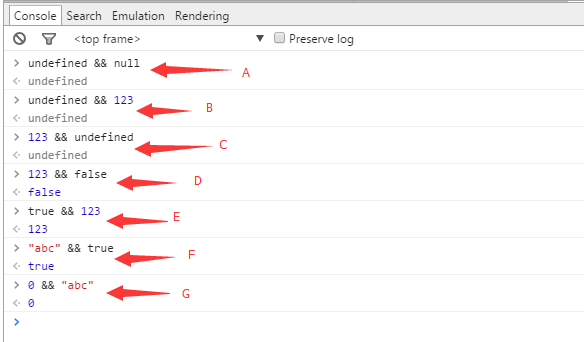
Still talking from the picture, at A: the left and right are undefined objects and empty objects respectively, and the value on the left is returned; at B, the left is an empty object, so the left is returned; at C: the right is an undefined object, so the value on the right is returned ; D: Same as C; E: Both are non-empty objects, and the Boolean value on the left is true, so the right is returned; F: The same as E; G: Because the left is 0, it is the same as an undefined object , the empty object is the same level as false, so the left value is returned.
The last one is a non-operation
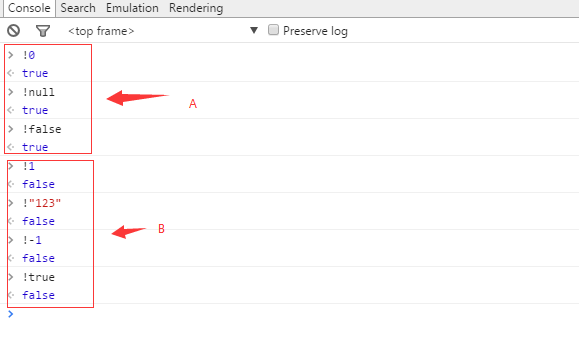
Continue to look at the picture and talk, at A: the operation is a value such as 0, false, null, undefined, etc., and when returned, the true value of the Boolean value is obtained; at B: the operation is to invert the real value, and the The main is the boolean value false. We can conclude that negation is a Boolean value, negation of an unreal value is correct, and negation of an actual value is an error.
Okay, that’s all for today. To summarize, today, I actually just talked about some very basic operators, but there are a lot of operators, so I just wrote this right to finish the expression. , and there are some special operators, which we will talk about later. As long as you make a little progress every day, it is not a dream to become a great master.

Hot AI Tools

Undresser.AI Undress
AI-powered app for creating realistic nude photos

AI Clothes Remover
Online AI tool for removing clothes from photos.

Undress AI Tool
Undress images for free

Clothoff.io
AI clothes remover

AI Hentai Generator
Generate AI Hentai for free.

Hot Article

Hot Tools

Notepad++7.3.1
Easy-to-use and free code editor

SublimeText3 Chinese version
Chinese version, very easy to use

Zend Studio 13.0.1
Powerful PHP integrated development environment

Dreamweaver CS6
Visual web development tools

SublimeText3 Mac version
God-level code editing software (SublimeText3)

Hot Topics
 How to implement an online speech recognition system using WebSocket and JavaScript
Dec 17, 2023 pm 02:54 PM
How to implement an online speech recognition system using WebSocket and JavaScript
Dec 17, 2023 pm 02:54 PM
How to use WebSocket and JavaScript to implement an online speech recognition system Introduction: With the continuous development of technology, speech recognition technology has become an important part of the field of artificial intelligence. The online speech recognition system based on WebSocket and JavaScript has the characteristics of low latency, real-time and cross-platform, and has become a widely used solution. This article will introduce how to use WebSocket and JavaScript to implement an online speech recognition system.
 WebSocket and JavaScript: key technologies for implementing real-time monitoring systems
Dec 17, 2023 pm 05:30 PM
WebSocket and JavaScript: key technologies for implementing real-time monitoring systems
Dec 17, 2023 pm 05:30 PM
WebSocket and JavaScript: Key technologies for realizing real-time monitoring systems Introduction: With the rapid development of Internet technology, real-time monitoring systems have been widely used in various fields. One of the key technologies to achieve real-time monitoring is the combination of WebSocket and JavaScript. This article will introduce the application of WebSocket and JavaScript in real-time monitoring systems, give code examples, and explain their implementation principles in detail. 1. WebSocket technology
 JavaScript and WebSocket: Building an efficient real-time weather forecasting system
Dec 17, 2023 pm 05:13 PM
JavaScript and WebSocket: Building an efficient real-time weather forecasting system
Dec 17, 2023 pm 05:13 PM
JavaScript and WebSocket: Building an efficient real-time weather forecast system Introduction: Today, the accuracy of weather forecasts is of great significance to daily life and decision-making. As technology develops, we can provide more accurate and reliable weather forecasts by obtaining weather data in real time. In this article, we will learn how to use JavaScript and WebSocket technology to build an efficient real-time weather forecast system. This article will demonstrate the implementation process through specific code examples. We
 Mind map of Python syntax: in-depth understanding of code structure
Feb 21, 2024 am 09:00 AM
Mind map of Python syntax: in-depth understanding of code structure
Feb 21, 2024 am 09:00 AM
Python is widely used in a wide range of fields with its simple and easy-to-read syntax. It is crucial to master the basic structure of Python syntax, both to improve programming efficiency and to gain a deep understanding of how the code works. To this end, this article provides a comprehensive mind map detailing various aspects of Python syntax. Variables and Data Types Variables are containers used to store data in Python. The mind map shows common Python data types, including integers, floating point numbers, strings, Boolean values, and lists. Each data type has its own characteristics and operation methods. Operators Operators are used to perform various operations on data types. The mind map covers the different operator types in Python, such as arithmetic operators, ratio
 Simple JavaScript Tutorial: How to Get HTTP Status Code
Jan 05, 2024 pm 06:08 PM
Simple JavaScript Tutorial: How to Get HTTP Status Code
Jan 05, 2024 pm 06:08 PM
JavaScript tutorial: How to get HTTP status code, specific code examples are required. Preface: In web development, data interaction with the server is often involved. When communicating with the server, we often need to obtain the returned HTTP status code to determine whether the operation is successful, and perform corresponding processing based on different status codes. This article will teach you how to use JavaScript to obtain HTTP status codes and provide some practical code examples. Using XMLHttpRequest
 Analysis of the meaning and usage of += operator in C language
Apr 03, 2024 pm 02:27 PM
Analysis of the meaning and usage of += operator in C language
Apr 03, 2024 pm 02:27 PM
The += operator is used to add the value of the left operand to the value of the right operand and assign the result to the left operand. It is suitable for numeric types and the left operand must be writable.
 How to get HTTP status code in JavaScript the easy way
Jan 05, 2024 pm 01:37 PM
How to get HTTP status code in JavaScript the easy way
Jan 05, 2024 pm 01:37 PM
Introduction to the method of obtaining HTTP status code in JavaScript: In front-end development, we often need to deal with the interaction with the back-end interface, and HTTP status code is a very important part of it. Understanding and obtaining HTTP status codes helps us better handle the data returned by the interface. This article will introduce how to use JavaScript to obtain HTTP status codes and provide specific code examples. 1. What is HTTP status code? HTTP status code means that when the browser initiates a request to the server, the service
 Python Operators: The Ultimate Guide from Newbie to Master
Mar 11, 2024 am 09:13 AM
Python Operators: The Ultimate Guide from Newbie to Master
Mar 11, 2024 am 09:13 AM
Introduction to python operators Operators are special symbols or keywords used to perform operations between two or more operands. Python provides a variety of operators covering a wide range of uses, from basic mathematical operations to complex data manipulation. Mathematical operators Mathematical operators are used to perform common mathematical operations. They include: operator operation examples + addition a + b - subtraction a-b * multiplication a * b / division a / b % modulo operation (take the remainder) a % b ** power operation a ** b // integer division (discard the remainder) a//b Logical Operators Logical operators are used to concatenate Boolean values and evaluate conditions. They include: operator operations examples and logical and aandbor logical or aorbnot logical not nota comparison operations






